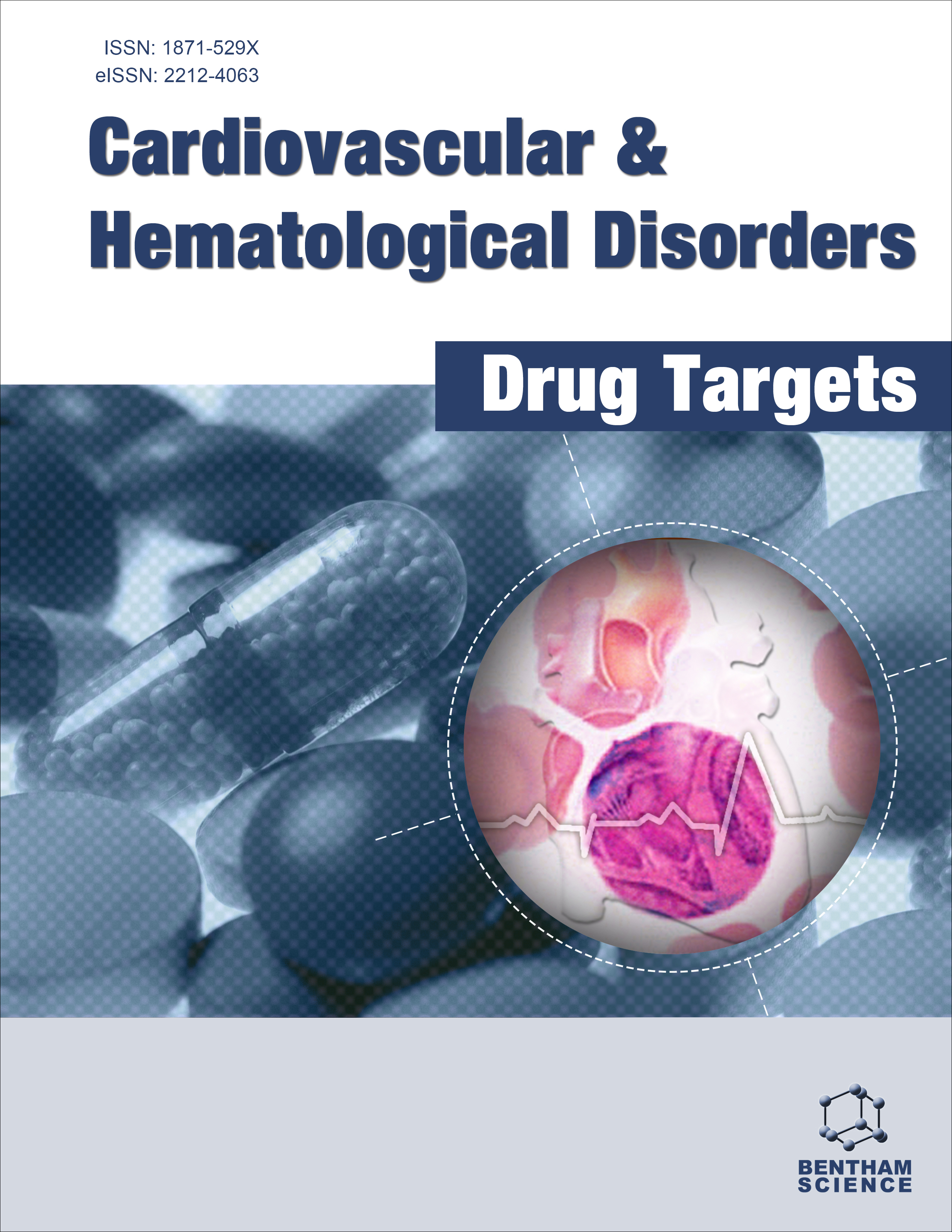- Home
- A-Z Publications
- Cardiovascular & Haematological Disorders - Drug Targets
- Previous Issues
- Volume 14, Issue 2, 2014
Cardiovascular & Haematological Disorders - Drug Targets - Volume 14, Issue 2, 2014
Volume 14, Issue 2, 2014
-
-
Editorial (Thematic Issue: Frontiers in Atherosclerosis, Heart Disease and Diabetes)
More LessBy Zemin YaoIn this issue of Cardiovascular & Hematological Disorders – Drug Targets, eight review articles are published with a common theme of Atherosclerosis, Heart Disease and Diabetes. The surge of metabolic syndromes in the past 2-3 decades, characterized by central obesity, hypertension, fasting hyperglycemia, and diabetic dyslipidemia, is associated with increasing incidence of heart diseases and vascular c Read More
-
-
-
Histone Methylation and Transcriptional Regulation in Cardiovascular Disease
More LessCardiovascular disease (CVD) represents a major health risk to the global population. In disease settings, cells that constitute the vasculature undergo profound changes both morphologically and functionally paralleling alterations in gene expression profile. At the transcriptional level, gene expression is steered by the epigenetic machinery including DNA methyltransferases, histone variants, non-coding regulatory RNAs, chr Read More
-
-
-
Cardiolipin Metabolism and the Role it Plays in Heart Failure and Mitochondrial Supercomplex Formation
More LessAuthors: Edgard M. Mejia, Laura K. Cole and Grant M. HatchCardiolipin is a major membrane phospholipid in the mitochondria and is essential for cellular energy metabolism mediated through mitochondrial oxidative phosphorylation. Recent studies indicate that it plays a diverse role in cellular metabolism. Eukaryotic cardiolipin is synthesized de novo from phosphatidic acid via the cytidine-5’-diphosphate- 1,2-diacyl-sn-glycerol pathway and is deacylated to monolysocardiolipin in order Read More
-
-
-
Transcriptional Control of Collagen I Gene Expression
More LessAuthors: Patricia Roche and Michael P. CzubrytCardiac fibrosis is the pathological remodeling of the extracellular matrix (ECM) in response to stresses such as pressure overload or injury [1]. While initially adaptive, myocardial remodeling and subsequent fibrosis causes increased wall stiffness, arrhythmias, cardiac dysfunction, and eventually heart failure [2]. Though the disease processes and origins may differ, excess deposition of fibrillar collagens type I and III ch Read More
-
-
-
Endothelial Cell Regulation of Cardiac Metabolism Following Diabetes
More LessAuthors: Fang Wang, Dahai Zhang, Andrea Wan and Brian RodriguesThe earliest change that occurs in the diabetic heart is reduced glucose consumption, with a switch to utilization of fatty acids (FA) predominantly as an energy resource. Although this adaptation might be beneficial in the short-term, over a protracted duration, it is potentially catastrophic given the malicious effects produced by high FA in cardiomyocytes. In this review, we describe how the endothelial cell (EC), a “first-responder Read More
-
-
-
Glucagon-Like Peptide-1 as a Key Regulator of Lipid and Lipoprotein Metabolism in Fasting and Postprandial States
More LessAuthors: Sarah Farr, Jennifer Taher and Khosrow AdeliInsulin resistance and the metabolic syndrome are associated with fasting and postprandial dyslipidemia. This involves the hepatic and intestinal overproduction of very low density lipoproteins (VLDL) and chylomicron particles, respectively, which give rise to atherogenic remnants upon lipolysis in the circulation. Recently, the insulin secretagogue glucagon-like peptide-1 (GLP-1) has received attention not only as an anti-d Read More
-
-
-
Effects of Diabetic HDL on Endothelial Cell Function
More LessAuthors: Dan He, Bing Pan, Hui Ren and Lemin ZhengType 2 diabetes mellitus (T2DM) is accompanied by dysfunctional high-density lipoprotein (HDL) and this is characterized by alterations in its composition and structure compared with HDL from normal subjects (N-HDL). HDL from diabetic subjects (D-HDL) has a diminished endothelial protective capacity including reducted ability to exert antioxidative activity, stimulate endothelial cell (EC) production of nitric oxide (NO) Read More
-
-
-
Caveolin-1 and ATP Binding Cassette Transporter A1 and G1-Mediated Cholesterol Efflux
More LessAuthors: Faqi Wang, Hong-mei Gu and Da-wei ZhangAtherosclerosis is one major cause of cardiovascular diseases, the leading cause of death in industrialized countries. Reverse cholesterol transport (RCT) is thought to be one primary pathway to protect against atherosclerosis. The first and rate-limiting step of RCT is ATP-binding cassette transport A1 (ABCA1) and ABCG1-mediated cholesterol efflux from the cells. Recently, caveolin-1 (CAV1), a scaffolding protein that orga Read More
-
-
-
Phospholipid Transfer Protein in Diabetes, Metabolic Syndrome and Obesity
More LessAuthors: Shucun Qin, Guohua Song and Yang YuIt has been reported that phospholipid transfer protein (PLTP) is an independent risk factor for human coronary artery disease. And metabolic tissues are important contributors to the systemic pools of PLTP protein. Consistently, PLTP mass and activity have been found to be elevated in the plasma of type 2 diabetes mellitus (T2DM) and obese patients. In this review, we summarized the recent progresses made in the PLTP re Read More
-
-
-
NOAC in Acute Coronary Syndrome and AF?
More LessAuthors: Maria Niespialowska-Steuden, Peter Collins, Charis Costopoulos and Diana A. GorogCardiovascular disease remains a major cause of morbidity and mortality in developed countries. New treatments, in the form of novel oral anticoagulants (NOAC) that reduce thrombotic risk are now available for patients with atrial fibrillation (AF) or acute coronary syndrome (ACS). Warfarin has been the cornerstone of thromboprophylaxis in patients with AF, but treatment is cumbersome, inconvenient and often unr Read More
-
Volumes & issues
-
Volume 24 (2024)
-
Volume 23 (2023)
-
Volume 22 (2022)
-
Volume 21 (2021)
-
Volume 20 (2020)
-
Volume 19 (2019)
-
Volume 18 (2018)
-
Volume 17 (2017)
-
Volume 16 (2016)
-
Volume 15 (2015)
-
Volume 14 (2014)
-
Volume 13 (2013)
-
Volume 12 (2012)
-
Volume 11 (2011)
-
Volume 10 (2010)
-
Volume 9 (2009)
-
Volume 8 (2008)
-
Volume 7 (2007)
-
Volume 6 (2006)
Most Read This Month
Article
content/journals/chddt
Journal
10
5
false
en


